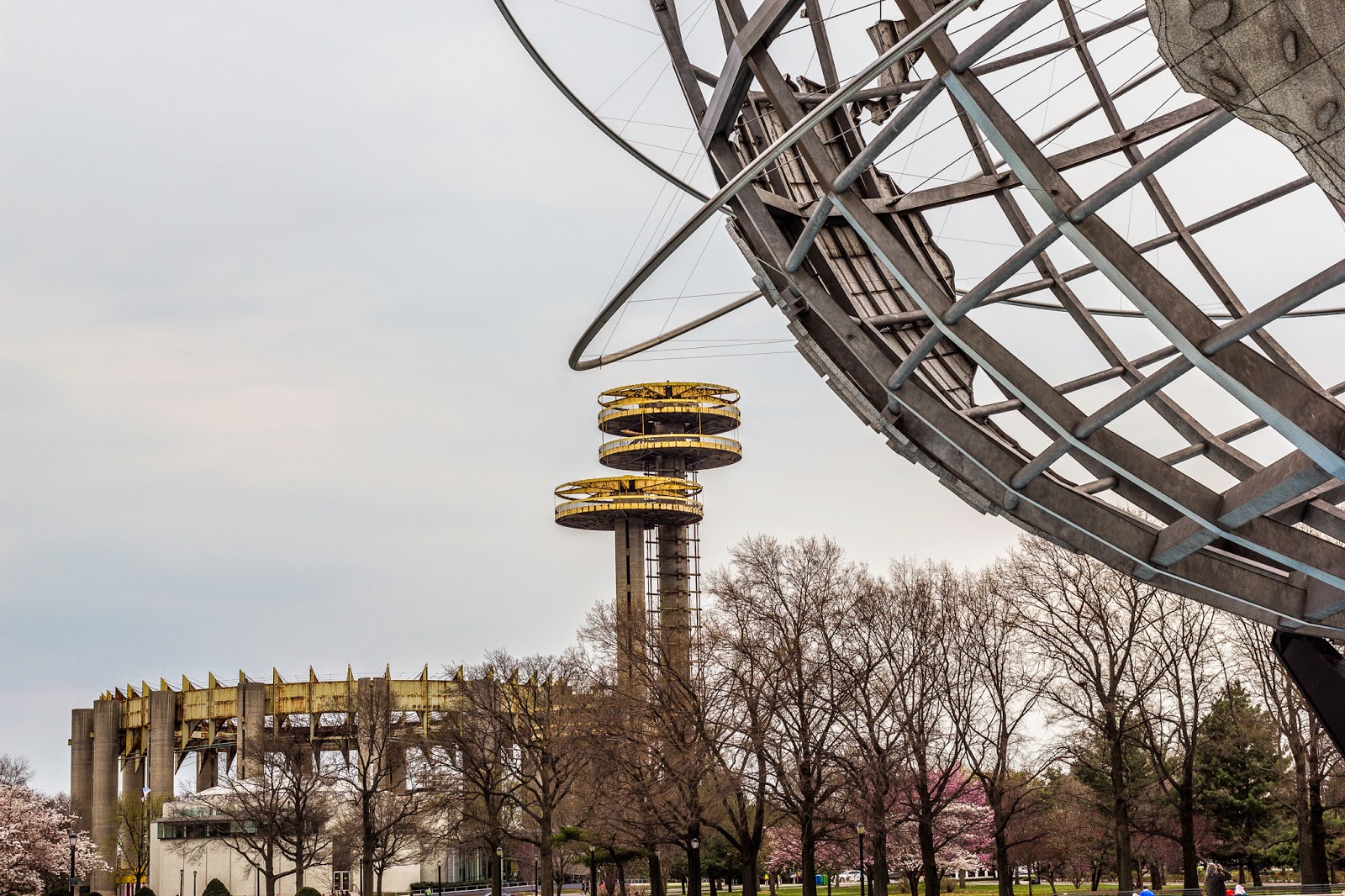 |
| Springtime in Flushing Meadows-Corona Park Canon 60D, EF40mm f/2.8, f/8, 1/500sec, 100ISO, 40mm |
Wednesday I posted photos from April 22nd of this year through the wide angle lens (World's Fair Wide Angle Wednesday). Today, I am adding some of the photos that were captured through my shorty forty (EF 40mm f/2.8 STM), and one from an old zoom lens I inherited (EF 75-300mm f/4-5.6 USM).
There is a Long Island Railroad station that serves Flushing-Meadows. It opened for the first World's Fair in 1939. When I first moved to Queens, it was the Shea Stadium stop, but now it is called Mets-Willets Point. This station is only operational during the US Open, and during Mets home games. Since the fall, the LIRR has been utilizing tracks 3 through 4 as a parking lot for some of the trains during the afternoons.
 |
| Red Bird in the wild Canon 60D, EF40mm f/2.8, f/10, 1/500sec, 100ISO, 40mm |
I spotted a Red Bird (9343) in the Corona Yard, the storage facility for the MTA's New York City Transit's 7 Trains. Though referred to as Red Birds, the R33 World's Fair cars were originally light turquoise and white. This car was delivered by the St. Louis Car Company in October of 1963. These cars were taken out of revenue service in November of 2003, so I did get a chance to ride the Red Birds after I moved to NYC. Some of them now serve as artificial reefs down the Atlantic Cost, a few are being preserved, and some, such as this one, serve as work cars.
Also visible in that photograph are the USTA Billie Jean King National Tennis Center, where the US Open is held, and the Unisphere, and the Observation Towers of the New York State Pavilion. The larger stadium is Arthur Ashe Stadium, which is the world's largest tennis specific stadium. It opened in 1997. The smaller stadium is Louis Armstrong Stadium, named after the jazz musician who lived close by in Corona, Queens. It served as the main stadium from 1978 until 1997 when Arthur Ashe Stadium opened.
 |
| Silver, silver, black and yellow Canon 60D, EF40mm f/2.8, f/8, 1/200sec, 100ISO, 40mm |
 |
| Unisphere looking North towards Arthur Ashe Stadium in Springtime Canon 60D, EF40mm f/2.8, f/9, 1/250sec, 125ISO, 40mm |
 |
| Dry Unisphere and Queens Museum Canon 60D, EF40mm f/2.8, f/8, 1/400sec, 320ISO, 40mm |
The Unisphere is located just outside of the Queens Museum, where I spent some of the time waiting. The thing is massive! The people in the above photograph give you a sense of the scale. It is 140' tall, and weighs 700,000lbs with a 100ton inverted tripod.
 |
| LGA, Riker's Island, Flushing Meadows-Corona Park, College Point from the "air" Canon 60D, EF40mm f/2.8, f/3.5, 1/80sec, 1600ISO, 40mm |
 |
| Flushing Meadows-Corona Park from the South looking North Canon 60D, EF75-300mm f/4-5.6 USM, f/4.5, 1/320sec, 6400ISO, 40mm |
When the Fair closed, the Panorama remained open to the public, and the map was updated regularly until 1970. It wasn't updated from 1970 until 1992, when 60,000 structures were added. Beginning in 2009, the Museum decided to try to keep it updated more regularly. People and organizations can donate money to adopt an accurate scale model of their building. The first updated model was the Mets' CitiField, which replaced Shea Stadium in 2009.
 |
| Downtown Manhattan Canon 60D, EF40mm f/2.8, f/3.5, 1/125sec, 1600ISO, 40mm |
One of the buildings that no longer exist in the skyline, the World Trade Center's Twin Towers, still remain on the map. They will be replaced when construction at the site is finished and the new buildings are complete, rather than a hole in the map.
 |
| Waiting... Canon 60D, EF40mm f/2.8, f/5, 1/320sec, 125ISO, 40mm |
After heading back to the gates of the Tent of Tomorrow, I waited outside for our number to be called. Hardhats were required once inside. I noticed they had placed blue decorative balls ontop of the rods just above the entrance, as it looked 50 years prior. And a flag was hung there as well.
 |
| Towers through the Tent Canon 60D, EF40mm f/2.8, f/8, 1/1000sec, 125ISO, 40mm |
I finally made it inside! We were told we had 10 minutes, so I tried to make the most of it, capturing some images with my shorty forty and switching to the wide angle lens. This was a once in a lifetime opportunity for me.
 |
| West Entrance with Texaco Canon 60D, EF40mm f/2.8, f/8, 1/250sec, 125ISO, 40mm |
They had restored some of the signage, such as the Texaco sign.
 |
| Planters Canon 60D, EF40mm f/2.8, f/8, 1/250sec, 125ISO, 40mm |
And the Restaurant sign as well...
 |
| Stitched Together Canon 60D, EF40mm f/2.8, f/8, 1/250sec, 125ISO, 40mm |
I took several photos and used Microsoft's Image Composite Editor to create this large image above. 15 images were combined to create the final product.
My time was up, I left and headed back to the LIRR to head home to Northeastern Queens. As I passed the Unisphere, I turned around and captured one final image of the Pavilion. One final image that day, as I have returned multiple times since April to the park and always seem to photograph it.
 |
| Remnants of the World's Fair in Spring Canon 60D, EF40mm f/2.8, f/8, 1/400sec, 320ISO, 40mm |
No comments:
Post a Comment